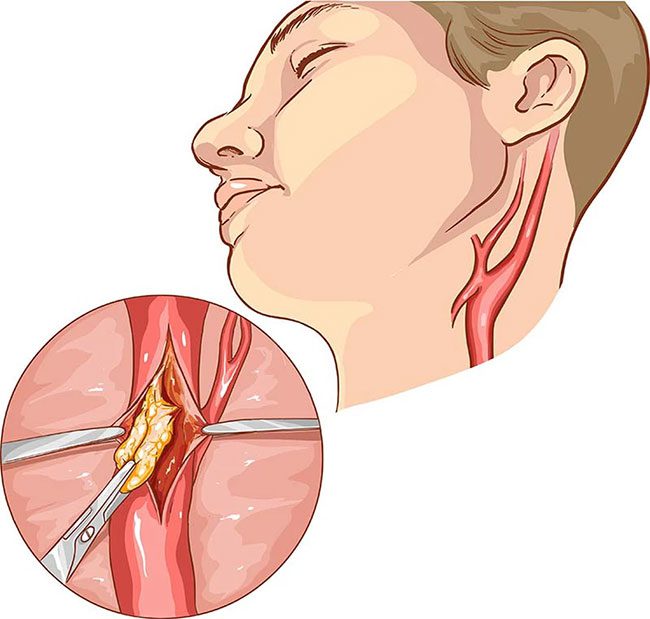The prevalence of carotid artery stenosis in the general population is estimated to be as high as 5%. Carotid artery stenosis is a condition that occurs over time, and as you age, it is also a potential underlying cause that increases the risk of stroke.
What You Need to Know About Carotid Artery Stenosis
1. What is Carotid Artery Stenosis?
The carotid arteries are the large arteries located on each side of the neck that supply blood to the brain, face, and head. When healthy, these arteries are smooth and unobstructed, functioning like clean pipes that allow fluid to flow freely without obstruction. You can feel your pulse in the carotid arteries on each side of your neck, just below the angle of your jaw.
Carotid artery stenosis occurs when these arteries become narrowed or obstructed. The obstruction is formed by a substance known as plaque (fatty cholesterol deposits). When this plaque blocks the normal blood flow through the carotid arteries, it reduces blood flow to the brain and increases the risk of stroke. The buildup of plaque is referred to as atherosclerosis.
Carotid artery stenosis is typically classified into three groups: mild, moderate, and severe. Mild stenosis is defined as obstruction of less than 50%, meaning that less than half of your artery is obstructed. Moderate stenosis ranges from 50% to 79%. The most severe classification involves significant obstruction of the artery, ranging from 80% to 99%.

Carotid artery stenosis occurs when this artery (in the neck) becomes obstructed. (Image: Internet).
2. Symptoms of Carotid Artery Stenosis
You may not experience any symptoms when suffering from carotid artery stenosis. Plaque accumulates in the carotid arteries over time without any warning signs until you suffer from a transient ischemic attack (TIA) or stroke. Therefore, regular health check-ups are crucial.
What are the symptoms of a stroke?
Be alert to the following symptoms of a stroke:
- Sudden loss of vision, blurred vision, or difficulty seeing in one or both eyes
- Weakness, tingling, or numbness on one side of the face, one side of the body, or in one arm or leg
- Sudden difficulty walking, loss of balance, lack of coordination
- Sudden dizziness or confusion
- Difficulty speaking (known as aphasia)
- Confusion
- Sudden severe headache
- Difficulty swallowing (known as dysphagia)

Sudden severe headache is one of the symptoms of a stroke. (Image: Internet).
What is a Transient Ischemic Attack (TIA)?
A transient ischemic attack (TIA) occurs when blood flow to the brain is temporarily reduced or blocked by a blood clot. With a TIA, you may experience symptoms similar to those of a stroke, but these symptoms last only a few minutes or hours and resolve on their own.
Individuals experiencing a TIA require emergency care because it is unpredictable whether this condition will develop into a more severe stroke. Findings show that individuals who have had a TIA are at a tenfold increased risk of having a severe stroke compared to those who have never had a TIA.
3. Causes and Risk Factors for Carotid Artery Stenosis
Atherosclerosis causes most cases of carotid artery stenosis. In this condition, fat accumulates along the inner lining of the arteries, forming plaques. The thickening narrows the arteries and reduces blood flow or completely blocks it to the brain.
Several factors may increase the risk of developing plaques in the arteries and causing carotid artery stenosis, such as:
- Smoking
- Obesity
- Sedentary lifestyle
- High blood pressure
- High cholesterol
- Diabetes
- Age

Older adults have a higher risk of carotid artery stenosis. (Image: Internet).
4. How to Diagnose Carotid Artery Stenosis
Carotid artery stenosis is often diagnosed after you experience stroke symptoms since the condition is usually asymptomatic before that. Doctors will perform a physical examination and various tests to determine the condition:
- Listening to the Carotid Artery: The doctor places a stethoscope on the carotid artery (in the neck) to listen for sounds.
- Ultrasound: Ultrasound is used to observe how blood flows through your arteries and to identify any areas where the arteries may be blocked or narrowed.
- Computed Tomography Angiography (CTA): CTA provides images of blood vessels and tissues, which is very useful in identifying narrowed blood vessels.
- Cerebral Angiography
- Magnetic Resonance Angiography (MRA)
5. Treatment for Carotid Artery Stenosis
The main goal of treating carotid artery stenosis is to prevent the progression of the disease. This starts with lifestyle modifications including a healthy diet, exercise, and quitting smoking.
Aspirin, blood pressure medications, and cholesterol-lowering drugs may also be used but should be taken as prescribed by a doctor.
In more severe cases, such as when the carotid artery is narrowed by more than 70%, patients may require surgery to reduce the risk of stroke following symptoms such as TIA or mild stroke.
Surgical treatments for carotid artery stenosis include:
- Carotid Endarterectomy (CEA): This is a procedure to remove plaque and clots from the carotid artery. Carotid endarterectomy can help prevent stroke in individuals with symptoms and stenosis of 70% or greater.
- Carotid Angioplasty with Stenting (CAS): This is an option for those who cannot undergo carotid endarterectomy. This method uses a very small hollow tube or catheter, which is threaded through the blood vessels from the groin to the carotid artery. After the catheter is placed, a balloon is inflated to open the artery and a stent is placed. A stent is a thin metal mesh framework used to keep the artery open.
Overall, treatment methods for carotid artery stenosis will depend on the physician. The doctor will assess the condition you are experiencing.

Maintaining a healthy lifestyle can prevent the development of carotid artery stenosis. (Image: Internet).
6. Advice for Those with Carotid Artery Stenosis and Prevention Tips
To keep carotid artery stenosis from progressing and to prevent this condition, you should make lifestyle changes based on the following advice:
- Quit smoking.
- Control high blood pressure.
- Manage diabetes.
- Control cholesterol levels.
- Eat a heart-healthy diet.
- Maintain a healthy weight.
- Exercise for at least 30 minutes most days of the week.
- Limit alcohol consumption to 1 drink per day for women and 2 drinks for men.
- Get regular health check-ups.
In summary, carotid artery stenosis is one of the potential underlying causes that increase the risk of stroke. This condition occurs over time and with age. Maintaining a healthy lifestyle and a balanced diet can reduce the risk of developing this condition.


















































